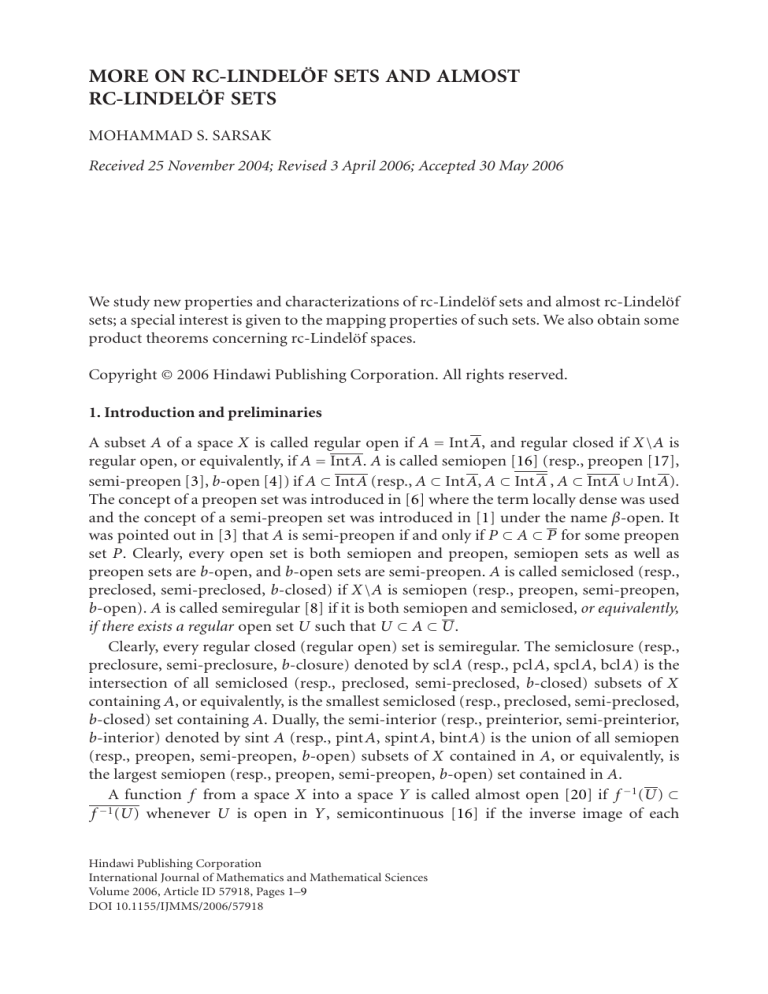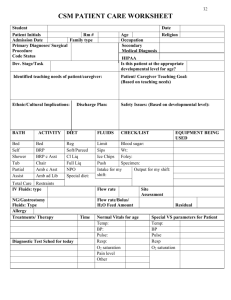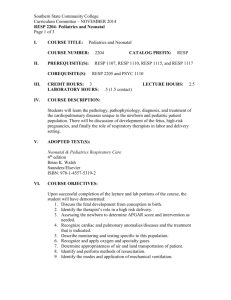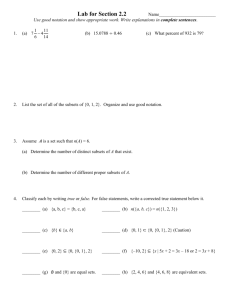
MORE ON RC-LINDELÖF SETS AND ALMOST
RC-LINDELÖF SETS
MOHAMMAD S. SARSAK
Received 25 November 2004; Revised 3 April 2006; Accepted 30 May 2006
We study new properties and characterizations of rc-Lindelöf sets and almost rc-Lindelöf
sets; a special interest is given to the mapping properties of such sets. We also obtain some
product theorems concerning rc-Lindelöf spaces.
Copyright © 2006 Hindawi Publishing Corporation. All rights reserved.
1. Introduction and preliminaries
A subset A of a space X is called regular open if A = IntA, and regular closed if X \A is
regular open, or equivalently, if A = IntA. A is called semiopen [16] (resp., preopen [17],
semi-preopen [3], b-open [4]) if A ⊂ IntA (resp., A ⊂ IntA, A ⊂ IntA , A ⊂ IntA ∪ IntA).
The concept of a preopen set was introduced in [6] where the term locally dense was used
and the concept of a semi-preopen set was introduced in [1] under the name β-open. It
was pointed out in [3] that A is semi-preopen if and only if P ⊂ A ⊂ P for some preopen
set P. Clearly, every open set is both semiopen and preopen, semiopen sets as well as
preopen sets are b-open, and b-open sets are semi-preopen. A is called semiclosed (resp.,
preclosed, semi-preclosed, b-closed) if X \A is semiopen (resp., preopen, semi-preopen,
b-open). A is called semiregular [8] if it is both semiopen and semiclosed, or equivalently,
if there exists a regular open set U such that U ⊂ A ⊂ U.
Clearly, every regular closed (regular open) set is semiregular. The semiclosure (resp.,
preclosure, semi-preclosure, b-closure) denoted by sclA (resp., pcl A, spcl A, bcl A) is the
intersection of all semiclosed (resp., preclosed, semi-preclosed, b-closed) subsets of X
containing A, or equivalently, is the smallest semiclosed (resp., preclosed, semi-preclosed,
b-closed) set containing A. Dually, the semi-interior (resp., preinterior, semi-preinterior,
b-interior) denoted by sint A (resp., pintA, spintA, bintA) is the union of all semiopen
(resp., preopen, semi-preopen, b-open) subsets of X contained in A, or equivalently, is
the largest semiopen (resp., preopen, semi-preopen, b-open) set contained in A.
A function f from a space X into a space Y is called almost open [20] if f −1 (U) ⊂
−
1
f (U) whenever U is open in Y , semicontinuous [16] if the inverse image of each
Hindawi Publishing Corporation
International Journal of Mathematics and Mathematical Sciences
Volume 2006, Article ID 57918, Pages 1–9
DOI 10.1155/IJMMS/2006/57918
2
More on rc-Lindelöf sets and almost rc-Lindelöf sets
open set is semiopen, β-continuous [1] if the inverse image of each open set is β-open,
weakly θ-irresolute [13] if the inverse image of each regular closed set is semiopen, rccontinuous [14] if the inverse image of each regular closed set is regular closed, and wrccontinuous [2] if the inverse image of each regular closed set is semi-preopen. We will
use the term semiprecontinuous to indicate β-continuous. Clearly, every semicontinuous
function is semi-precontinuous, every rc-continuous function is weakly θ-irresolute, and
every weakly θ-irresolute function is wrc-continuous. It is also easy to see that a function that is both semicontinuous (resp., semi-precontinuous) and almost open is weakly
θ-irresolute (resp., wrc-continuous).
A function f from a space X into a space Y is called somewhat continuous [12] if for
each nonempty open set V in Y , int f −1 (V ) = φ.
A space X is called a weak P-space [18] if for each countable family {Un : n ∈ N} of
open subsets of X, ∪Un = ∪U n . Clearly, X is a weak P-space if and only if the countable
union of regular closed subsets of X is regular closed (closed).
A space X is called rc-Lindelöf [15] (resp., nearly Lindelöf [5]) if every regular closed
(resp., regular open) cover of X has a countable subcover, and called almost rc-Lindelöf
[10] if every regular closed cover of X has a countable subfamily whose union is dense in
X.
A subset A of a space X is called an S-set in X [7] if every cover of A by regular closed
subsets of X has a finite subcover, and called an rc-Lindelöf set in X (resp., an almost rcLindelöf set in X) [9] if every cover of A by regular closed subsets of X admits a countable
subfamily that covers A (resp., the closure of the union of whose members contains A).
Obviously, every S-set is an rc-Lindelöf set and every rc-Lindelöf set is an almost rcLindelöf set; it is also clear that a subset A of a weak P-space X is rc-Lindelöf in X if and
only if it is almost rc-Lindelöf in X.
Throughout this paper, N denotes the set of natural numbers. For the concepts not
defined here, we refer the reader to Engelking [11].
In concluding this section, we recall the following facts for their importance in the
material of our paper.
Theorem 1.1 [9]. If A is an rc-Lindelöf (resp., almost rc-Lindelöf) set in a space X and B
is a regular open subset of X, then A ∩ B is rc-Lindelöf (resp., almost rc-Lindelöf) in X. In
particular, a regular open subset A of an rc-Lindelöf (resp., almost rc-Lindelöf) space X is
rc-Lindelöf (resp., almost rc-Lindelöf) in X.
Theorem 1.2 [9]. Let A be a preopen subset of a space X and B ⊂ A. Then B is rc-Lindelöf
(resp., almost rc-Lindelöf) in X if and only if B is rc-Lindelöf (resp., almost rc-Lindelöf) in
A. In particular, a preopen subset A of a space X is rc-Lindelöf (resp., almost rc-Lindelöf) in
X if and only if A is an rc-Lindelöf (resp., almost rc-Lindelöf) subspace.
Proposition 1.3 [19]. If A is an almost rc-Lindelöf set in a space X and A ⊂ B ⊂ A, then
B is almost rc-Lindelöf in X.
Proposition 1.4 [9]. The countable union of rc-Lindelöf (resp., almost rc-Lindelöf) sets in
a space X is rc-Lindelöf (resp., almost rc-Lindelöf) in X.
Mohammad S. Sarsak 3
Proposition 1.5 [9]. A subset A of a space X is rc-Lindelöf (resp., almost rc-Lindelöf) in
X if and only if every cover of A by semiopen subsets of X admits a countable subfamily the
union of the closures of whose members (resp., the closure of the union of whose members)
contains A.
Proposition 1.6 [19]. Let A be a preopen, almost rc-Lindelöf set in a space X and B a
regular closed subset of X, then A ∩ B is almost rc-Lindelöf in X. In particular, a regular
closed subset A of an almost rc-Lindelöf space X is almost rc-Lindelöf in X.
Lemma 1.7. If A is a preopen subset of a space X and U is open in X, then A ∩ U ∩ A =
U ∩ A.
2. Further properties
This section is devoted to study new properties concerning rc-Lindelöf sets and almost
rc-Lindelöf sets. We obtain several characterizations of rc-Lindelöf sets and almost rcLindelöf sets.
The following proposition is an improvement of Proposition 1.6 and the fact of
Theorem 1.1 that a regular open subset of an almost rc-Lindelöf space X is almost rcLindelöf in X.
Proposition 2.1. Let A be a preopen, almost rc-Lindelöf set in a space X and B a semiregular subset of X, then A ∩ B is almost rc-Lindelöf in X. In particular, a semiregular subset A
of an almost rc-Lindelöf space X is almost rc-Lindelöf in X.
Proof. Since B is a semiregular subset of X, there exists a regular open subset U of X such
that U ⊂ B ⊂ U, thus by Lemma 1.7, it follows that A ∩ U ⊂ A ∩ B ⊂ U ∩ A ⊂ A ∩ U.
Since A is almost rc-Lindelöf set in X, it follows from Theorem 1.1 that A ∩ U is almost
rc-Lindelöf set in X. The result yields from Proposition 1.3.
Proposition 2.2 [19]. If A is a regular closed subset of a space X such that A is almost
rc-Lindelöf in X, then A is an almost rc-Lindelöf.
The following proposition includes an improvement of Proposition 2.2.
Proposition 2.3. Let A be a semiopen subset of a space X and B ⊂ A. If B is rc-Lindelöf
(resp., almost rc-Lindelöf) in X , then B is rc-Lindelöf (resp., almost rc-Lindelöf) in A. In
particular, if A is a semiopen subset of a space X such that A is rc-Lindelöf (resp., almost
rc-Lindelöf) in X, then A is an rc-Lindelöf (resp., almost rc-Lindelöf) subspace.
Proof. Follows from Proposition 1.5 and the fact that if A is a semiopen subset of a space
X and B is semiopen in A, then B is semiopen in X.
Corollary 2.4 [2]. Let X be an rc-Lindelöf weak P-space. If U ⊂ A ⊂ U, where U is a
regular open subset of X, then A is an rc-Lindelöf subspace.
Proof. By Theorem 1.1, U is an rc-Lindelöf set in X and thus almost rc-Lindelöf in X.
By Proposition 1.3, A is almost rc-Lindelöf in X, but X is a weak P-space, so A is rcLindelöf in X. Finally, since A is semiopen (it is moreover semiregular), it follows from
Proposition 2.3 that A is an rc-Lindelöf subspace.
4
More on rc-Lindelöf sets and almost rc-Lindelöf sets
The following theorem includes new characterizations of rc-Lindelöf sets and almost
rc-Lindelöf sets.
Theorem 2.5. Let A be a subset of a space X. Then the following are equivalent.
(i) A is rc-Lindelöf (resp., almost rc-Lindelöf) in X.
(ii) Every cover of A by semi-preopen subsets of X admits a countable subfamily the union
of the closures of whose members (resp., the closure of the union of whose members)
contains A.
(iii) Every cover of A by b-open subsets of X admits a countable subfamily the union of
the closures of whose members (resp., the closure of the union of whose members)
contains A.
(iv) Every cover of A by semiopen subsets of X admits a countable subfamily the union
of the closures of whose members (resp., the closure of the union of whose members)
contains A.
(v) Every cover of A by semiregular subsets of X admits a countable subfamily the union
of the closures of whose members (resp., the closure of the union of whose members)
contains A.
Proof. (i)⇒(ii): follows since the closure of a semi-preopen set is regular closed.
(ii)⇒(iii)⇒(iv)⇒(v)⇒(i): follows from the following implications: regular closed⇒
semiregular⇒semiopen⇒ b-open⇒semi-preopen.
The following theorem also characterizes rc-Lindelöf sets and almost rc-Lindelöf sets,
it is a direct consequence of Theorem 2.5 and the definition of rc-Lindelöf (almost rc
Lindelöf) sets.
Theorem 2.6. Let A be a subset of a space X. Then the following are equivalent.
(i) A is rc-Lindelöf (resp., almost rc-Lindelöf) in X.
(ii) If U∼ = {Uα : α ∈ Λ} is a family of regular open subsets of X satisfying that for any
countable subcollection U∼∗ of U∼ , A ∩ (∩U∼∗ ) = φ (resp., A ∩ int(∩U∼∗ ) = φ), then
A ∩ (∩U∼ ) = φ.
(iii) If U∼ = {Uα : α ∈ Λ} is a family of semi-preclosed subsets of X satisfying that for
any countable subcollection U∼∗ of U∼ , A ∩ (∩{intU : U ∈ U∼∗ }) = φ (resp., A ∩
int(∩U∼∗ ) = φ), then A ∩ (∩U∼ ) = φ.
(iv) If U∼ = {Uα : α ∈ Λ} is a family of b-closed subsets of X satisfying that for any countable subcollection U∼∗ of U∼ , A ∩ (∩{intU : U ∈ U∼∗ }) = φ (resp., A ∩ int(∩U∼∗ ) =
φ), then A ∩ (∩U∼ ) = φ.
(v) If U∼ = {Uα : α ∈ Λ} is a family of semiclosed subsets of X satisfying that for any
countable subcollection U∼∗ of U∼ , A ∩ (∩{intU : U ∈ U∼∗ })= φ (resp., A ∩ int(∩U∼∗ )
= φ), then A ∩ (∩U∼ ) = φ.
(vi) If U∼ = {Uα : α ∈ Λ} is a family of semiregular subsets of X satisfying that for any
countable subcollection U∼∗ of U∼ , A ∩ (∩{intU : U ∈ U∼∗ })= φ (resp., A ∩ int(∩U∼∗ )
= φ), then A ∩ (∩U∼ ) = φ.
3. Invariance properties
In this section, we mainly study several types of functions that preserve the property of
being an rc-Lindelöf (almost rc-Lindelöf) set.
Mohammad S. Sarsak 5
Definition 3.1 [19]. A function f from a space X into a space Y is said to be slightly
continuous if f (U) ⊂ f (U) whenever U is open in X.
In [19], it was shown that if a function f : X → Y is slightly continuous and weakly
θ-irresolute, then f (A) is almost rc-Lindelöf in Y whenever A is almost rc-Lindelöf set
in X. The following theorem is analogous to this result; it has a similar proof that we will
mention for the convenience of the reader.
Theorem 3.2. Let f : X → Y be a slightly continuous and weakly θ-irresolute function. If A
is rc-Lindelöf set in X, then f (A) is rc-Lindelöf in Y .
Proof. Let {Uα : α ∈ Λ} be a cover of f (A) by regular closed subsets of X. Then { f −1 (Uα ) :
α ∈ Λ} is a cover of A by semiopen subsets of X (as f is weakly θ-irresolute). Since A
is rc-Lindelöf
in X, it follows from Proposition 1.5 that there exist α1 ,α2 ,... ∈ Λ such
−1 (U ). For each i ∈ N, there is an open subset V of X such that V ⊂
that A ⊂ ∞
αi
i
i
i=1 f
f −1 (Uαi ) ⊂ V i and thus ∞
f −1 (Uαi ) = ∞
Vi . Since f is slightly continuous, it follows
i
=
1
i
=
1
∞
∞
that f (A) ⊂ ∞
i=1 f (Vi ) ⊂ i=1 Uαi = i=1 Uαi . Hence f (A) is rc-Lindelöf in Y .
Corollary 3.3. Let f : X → Y be a slightly continuous, semicontinuous, and almost open
function. If A is rc-Lindelöf (resp., almost rc-Lindelöf) in X, then f (A) is rc-Lindelöf (resp.,
almost rc-Lindelöf) in Y .
Corollary 3.4. Let f : X → Y be a surjective, slightly continuous, semicontinuous, and
almost open function. If X is rc-Lindelöf, then Y is rc-Lindelöf.
It will be seen later that the condition slightly continuous of Corollary 3.4 is not essential for preserving the almost rc-Lindelöf property.
Corollary 3.5 [2]. Let f : X → Y be a surjective, continuous, and almost open function. If
X is rc-Lindelöf, then Y is rc-Lindelöf.
Obviously, every continuous function is both semicontinuous and slightly continuous.
However, the converse is not true as the following example tells.
Example 3.6. Let X = {a,b,c}, τ = {X,φ, {a}}, τ ∗ = {X,φ, {a,b}}. Then the identity function from (X,τ) onto (X,τ ∗ ) is a semicontinuous, slightly continuous, and almost open
surjection. However, it is not continuous.
Proposition 3.7. Let f : X → Y be a semicontinuous function. If X is extremally disconnected (i.e., every regular closed subset of X is open), then f is slightly continuous.
Proof. Let U be open in X. Then scl(U) = U ∪ intU = U (as X is extremally disconnected). Since f is semicontinuous, it follows that f (scl(U)) = f (U) ⊂ f (U). Hence f is
slightly continuous.
The following corollary is an immediate consequence of Corollary 3.4 and Proposition
3.7.
Corollary 3.8 [2]. Let f : X → Y be a semicontinuous, almost open surjection, where X is
extremally disconnected. If X is rc-Lindelöf, then Y is rc-Lindelöf.
6
More on rc-Lindelöf sets and almost rc-Lindelöf sets
The following example shows that if X is extremally disconnected and f : X → Y is
slightly continuous, almost open surjection, then f need not be semicontinuous.
Example 3.9. Let X = {a,b,c}, τ = {X,φ, {a,b}}, τ ∗ = {X,φ, {a}}. Then (X,τ) is extremally disconnected, also the identity function from (X,τ) onto (X,τ ∗ ) is slightly continuous and almost open ; it is, however, not semicontinuous.
Proposition 3.10 [10]. (i) Let f : X → Y be a somewhat continuous and weakly θ-irresolute function. If X is almost rc-Lindelöf, then Y is almost rc-Lindelöf.
(ii) Let f : X → Y be a surjective, semicontinuous, and weakly θ-irresolute function. If X
is almost rc-Lindelöf, then Y is almost rc-Lindelöf.
Corollary 3.11. Let f : X → Y be a surjective, semicontinuous, and almost open function.
If X is almost rc-Lindelöf, then Y is almost rc-Lindelöf.
The following corollary is an immediate consequence of Corollary 3.11 and the fact
that for a weak P-space, the concepts of being rc-Lindelöf and almost rc-Lindelöf coincide.
Corollary 3.12 [2]. Let f : X → Y be a surjective, semicontinuous, and almost open function, where Y is a weak P-space. If X is rc-Lindelöf, then Y is rc-Lindelöf.
Definition 3.13. A function f : X → Y is said to be somewhat precontinuous if for each
nonempty open set V in Y , p int f −1 (V ) = φ.
Remark 3.14. It was pointed out in [10] that every surjective semicontinuous function is
somewhat continuous, a similar result that may be pointed out here asserts that every surjective semi-precontinuous function is somewhat precontinuous. However, the converses
of these two facts are not true as the following two examples tell.
Example 3.15. Let X = {a,b,c}, τ = {X,φ, {a,b}, {c}}, τ ∗ = {X,φ, {a,c}}. Then the identity function from (X,τ) onto (X,τ ∗ ) is somewhat continuous; it is, however, not semicontinuous.
Example 3.16. Let X = {a,b,c,d}, τ = {X,φ, {b}, {d}, {b,d }, {a,d }, {a,b,d }}, τ ∗ = {X,φ,
{a,b}}. Then the identity function from (X,τ) onto (X,τ ∗ ) is even somewhat continuous
and thus somewhat precontinuous; it is, however, not semi-precontinuous since {a,b} is
not semi-preopen in (X,τ).
The following result is a slight improvement of Proposition 3.10(i), the similar proof
follows from Theorem 2.5 and the fact that if A is a semiopen subset of a space X, then
pcl(A) = A.
Proposition 3.17. (i) Let f : X → Y be a somewhat continuous and wrc-continuous function. If X is almost rc-Lindelöf, then Y is almost rc-Lindelöf.
(ii) Let f : X → Y be a somewhat precontinuous and weakly θ-irresolute function. If X is
almost rc-Lindelöf, then Y is almost rc-Lindelöf.
Remark 3.18. Clearly, every somewhat continuous function is somewhat precontinuous
and every weakly θ-irresolute function is wrc-continuous. However, the following two examples show that the property of being both somewhat continuous and wrc-continuous
Mohammad S. Sarsak 7
and the property of being both somewhat precontinuous and weakly θ-irresolute are independent.
Example 3.19. Let X = {a,b,c}, τ = {X,φ, {a,b}}, τ ∗ = {X,φ, {a,c}}. Then the identity
function from (X,τ) onto (X,τ ∗ ) is somewhat precontinuous and weakly θ-irresolute; it
is, however, not somewhat continuous.
Example 3.20. Let X = {a,b,c, d}, τ = {X,φ, {a}, {b,c}, {d}, {a,b,c}, {a,d }, {b,c,d }}, τ ∗ =
{X,φ, {a,b}, {d }, {a,b,d }}. Then the identity function from (X,τ) onto (X,τ ∗ ) is somewhat continuous and wrc-continuous; it is, however, not weakly θ-irresolute (observe
that {d,c} is regular closed in (X,τ ∗ ) but not semiopen in (X,τ)).
The following result is a slight improvement of Proposition 3.10(ii), it is a direct consequence of Remark 3.14 and Proposition 3.17.
Corollary 3.21. (i) Let f : X → Y be a surjective, semicontinuous, and wrc-continuous
function. If X is almost rc-Lindelöf, then Y is almost rc-Lindelöf.
(ii) Let f : X → Y be a surjective, semi-precontinuous, and weakly θ-irresolute function.
If X is almost rc-Lindelöf, then Y is almost rc-Lindelöf.
Corollary 3.22 [2]. Let f : X → Y be a somewhat continuous and wrc-continuous surjection, where Y is a weak P-space. If X is rc-Lindelöf, then Y is rc-Lindelöf.
Corollary 3.22 is still true even if the function f is not surjective.
4. Product theorems
In this section, we study some types of functions that inversely preserve the property of
being an rc-Lindelöf (almost rc-Lindelöf) set. We mainly obtain some product theorems
concerning rc-Lindelöf spaces.
Definition 4.1 [19]. A function f from a space X into a space Y is said to be regular open
if it maps regular open subsets onto regular open subsets.
Definition 4.2 [19]. (i) A subset A of a space X is said to be an rc-Fσ subset if A is the
countable union of regular closed subsets.
(ii) A function f from a space X into a space Y is said to be weakly almost open if
f −1 (A) ⊂ f −1 (A) whenever A is an rc-Fσ subset of Y .
In [19], it was shown that every almost open function is weakly almost open, but not
conversely.
Theorem 4.3 [19]. Let f be a weakly almost open and regular open function from a space
X onto a space Y . Then the following hold.
(i) If for each y ∈ Y , f −1 (y) is an S-set in X, then X is almost rc-Lindelöf whenever Y
is almost rc-Lindelöf.
(ii) If for each y ∈ Y , f −1 (y) is rc-Lindelöf in X, then X is almost rc-Lindelöf whenever
Y is almost rc-Lindelöf provided that X is a weak P-space.
We point out here that in the result of Theorem 4.3(ii), X being almost rc-Lindelöf
may be replaced by rc-Lindelöf since X is a weak P-space.
8
More on rc-Lindelöf sets and almost rc-Lindelöf sets
Theorem 4.3 may be improved in the following form.
Theorem 4.4. Let f be a weakly almost open and regular open function from a space X
onto a space Y . Then the following hold.
(i) If for each y ∈ Y , f −1 (y) is an S-set in X, then f −1 (A) is almost rc-Lindelöf in X
whenever A is almost rc-Lindelöf in Y .
(ii) If for each y ∈ Y , f −1 (y) is rc-Lindelöf in X, then f −1 (A) is rc-Lindelöf in X whenever A is almost rc-Lindelöf in Y provided that X is a weak P-space.
The following theorem shows that the assumption weakly almost open of Theorem 4.4
is not essential for the inverse preservation of the rc-Lindelöf set property.
Theorem 4.5. Let f be a regular open function from a space X onto a space Y . Then the
following hold.
(i) If for each y ∈ Y , f −1 (y) is an S-set in X, then f −1 (A) is rc-Lindelöf in X whenever
A is rc-Lindelöf in Y .
(ii) If for each y ∈ Y , f −1 (y) is rc-Lindelöf in X, then f −1 (A) is rc-Lindelöf in X whenever A is rc-Lindelöf in Y provided that X is a weak P-space.
The proof of the following proposition is straightforward and thus omitted.
Proposition 4.6. Let X be a nearly Lindelöf space and Y a weak P-space. Then the projection function p : X × Y → Y sends regular closed sets onto closed sets.
Corollary 4.7. Let X, Y be two spaces such that Y is rc-Lindelöf and X × Y is extremally
disconnected. Then the following hold.
(i) If X is compact, then X × Y is rc-Lindelöf [2].
(ii) If X is Lindelöf, then X × Y is rc-Lindelöf provided that X × Y is a weak P-space.
Proof. We will show (ii), the other part is similar. Consider the projection function p :
X × Y → Y . Since X × Y is a weak P-space, it follows that Y is a weak P-space, but X
is Lindelöf and thus nearly Lindelöf, so by Proposition 4.6, p : X × Y → Y sends regular
closed sets onto closed sets, but X × Y is extremally disconnected, so every regular open
subset of X × Y is regular closed and thus p : X × Y → Y sends regular open sets onto
closed sets, but p is an open function, so p is regular open. Also for each y ∈ Y , p−1 (y) =
X × { y } is rc-Lindelöf in X × Y (as X is Lindelöf and X × Y is extremally disconnected).
Finally, since Y is rc-Lindelöf, it follows immediately from Theorem 4.5(ii) that X × Y is
rc-Lindelöf.
The following result is an improvement of Corollary 4.7, it follows from Theorem 1.2,
Proposition 1.4, Corollary 4.7, and the fact that the properties of being extremally dis
connected (a weak P-space) are hereditary with respect to open subsets.
Corollary 4.8. Let X, Y be two rc-Lindelöf spaces such that X × Y is extremally disconnected. Then the following hold.
(i) If X is locally compact, that is, for each x ∈ X, there exists an open set Ux containing
x such that Ux is compact, then X × Y is rc-Lindelöf.
(ii) If X is locally Lindelöf, that is, for each x ∈ X, there exists an open set Ux containing
x such that Ux is Lindelöf, then X × Y is rc-Lindelöf provided that X × Y is a weak
P-space.
Mohammad S. Sarsak 9
Acknowledgment
The author is grateful to the referee for his/her careful reading of the manuscript and for
the valuable suggestions.
References
[1] M. E. Abd El-Monsef, S. N. El-Deeb, and R. A. Mahmoud, β-open sets and β-continuous mapping,
Bulletin of the Faculty of Science. Assiut University. A. Physics and Mathematics 12 (1983), no. 1,
77–90.
[2] B. Al-Nashef and K. Al-Zoubi, A note on rc-Lindelof and related spaces, Questions and Answers
in General Topology 21 (2003), no. 2, 159–170.
[3] D. Andrijević, Semi-preopen sets, Matematichki Vesnik 38 (1986), no. 1, 24–32.
, On b-open sets, Matematichki Vesnik 48 (1996), no. 1-2, 59–64.
[4]
[5] G. Balasubramanian, On some generalizations of compact spaces, Glasnik Matematički. Serija III
17(37) (1982), no. 2, 367–380.
[6] H. H. Corson and E. Michael, Metrizability of certain countable unions, Illinois Journal of Mathematics 8 (1964), 351–360.
[7] G. Di Maio, S-closed spaces, S-sets and S-continuous functions, Atti della Accademia delle Scienze
di Torino 118 (1984), no. 3-4, 125–134.
[8] G. Di Maio and T. Noiri, On s-closed spaces, Indian Journal of Pure and Applied Mathematics 18
(1987), no. 3, 226–233.
[9] K. Dlaska, rc-Lindelöf sets and almost rc-Lindelöf sets, Kyungpook Mathematical Journal 34
(1994), no. 2, 275–281.
[10] K. Dlaska and M. Ganster, Almost rc-Lindelöf spaces, Bulletin of the Malaysian Mathematical
Sciences Society. Second Series 17 (1994), 51–56.
[11] R. Engelking, General Topology, Sigma Series in Pure Mathematics, vol. 6, Heldermann, Berlin,
1989.
[12] Z. Frolı́k, Remarks concerning the invariance of Baire spaces under mappings, Czechoslovak Mathematical Journal 11 (86) (1961), 381–385.
[13] M. Ganster, T. Noiri, and I. L. Reilly, Weak and strong forms of θ-irresolute functions, Journal of
Institute of Mathematics & Computer Sciences. (Mathematics Series) 1 (1988), no. 1, 19–29.
[14] D. S. Janković, A note on mappings of extremally disconnected spaces, Acta Mathematica Hungarica 46 (1985), no. 1-2, 83–92.
[15] D. S. Janković and C. Konstadilaki, On covering properties by regular closed sets, Mathematica
Pannonica 7 (1996), no. 1, 97–111.
[16] N. Levine, Semi-open sets and semi-continuity in topological spaces, The American Mathematical
Monthly 70 (1963), no. 1, 36–41.
[17] A. S. Mashhour, M. E. Abd El-Monsef, and S. N. El-Deep, On precontinuous and weak precontinuous mappings, Proceedings of the Mathematical and Physical Society of Egypt (1982), no. 53,
47–53 (1983).
[18] T. K. Mukherji and M. Sarkar, On a class of almost discrete spaces, Matematichki Vesnik 3(16)(31)
(1979), no. 4, 459–474.
[19] M. S. Sarsak, On almost rc-Lindelöf sets, Acta Mathematica Hungarica 100 (2003), no. 1-2, 1–7.
[20] A. Wilansky, Topics in Functional Analysis, Lecture Notes in Mathematics, no. 45, Springer,
Berlin, 1967.
Mohammad S. Sarsak: Department of Mathematics, Faculty of Science, The Hashemite University,
P.O. Box 150459, Zarqa 13115, Jordan
E-mail address: sarsak@hu.edu.jo








